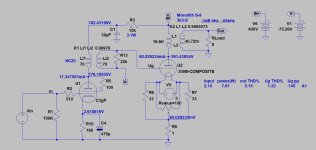Hi,
First post here after reading many interesting and enlightening topics. I’ve just finished a simple 45 amplifier, and was so positively surprised I decided to build a second amp. This so the 45 can do what I built it for: drive my headphones in the office.
I just made the mistake of trying it on my speakers and despite their low efficiency the sound is so addictive the amp is not moving to the office until I’ve built a proper “speaker” amp!
So here we are, I’d like to build a 300B amp: I’ve acquired a pair of tango NC20 interstage transformers (original make) and have a set of Audio-note Output transformers (single ended). All I need is a schematic
I do like the idea of keeping everything DHT and simple, because then it’s easier to grasp given my limited knowledge and philosophically I like simple: also this would allow me to study the effect of swapping individual components to tailor the sound. (I’m not looking for something that measures well per se, it should sound well, not for opening that discussion )
)
I like the 45 sound but that probably has too little amplification to keep it two stages, which would be the preference, also one could avoid coupling capacitors but am open to be convinced otherwise. Should I look at a 10y? EML 30a?
In any case curious to hear peoples thoughts.
Cheers!
Matthew
First post here after reading many interesting and enlightening topics. I’ve just finished a simple 45 amplifier, and was so positively surprised I decided to build a second amp. This so the 45 can do what I built it for: drive my headphones in the office.
I just made the mistake of trying it on my speakers and despite their low efficiency the sound is so addictive the amp is not moving to the office until I’ve built a proper “speaker” amp!
So here we are, I’d like to build a 300B amp: I’ve acquired a pair of tango NC20 interstage transformers (original make) and have a set of Audio-note Output transformers (single ended). All I need is a schematic
I do like the idea of keeping everything DHT and simple, because then it’s easier to grasp given my limited knowledge and philosophically I like simple: also this would allow me to study the effect of swapping individual components to tailor the sound. (I’m not looking for something that measures well per se, it should sound well, not for opening that discussion
I like the 45 sound but that probably has too little amplification to keep it two stages, which would be the preference, also one could avoid coupling capacitors but am open to be convinced otherwise. Should I look at a 10y? EML 30a?
In any case curious to hear peoples thoughts.
Cheers!
Matthew
I used to use 300b and 2a3 but got better results with EL12 or EL12n in the output stage driven by a DHT in a 2 stage SE amp. I like the 26 but you could use a 10Y. The gain of the EL12 in triode is 18 so a DHT drives it OK, and 2 stages always sound cleaner to me than 3 stages. The DHT in the input gives the whole amp that special DHT quality. It's a much better driver than all the 9 pin tubes you can throw at a 300b.
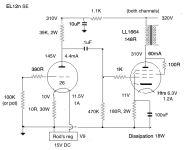

First of all: in the "classic" operating point of 300B (350V, 60-70mA) the grid (to cathode) voltage is -72 ..75V.
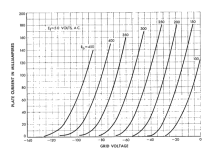
The requiring grid swing (up to A1) about 150Vpp.
The NC20 is 1:1 interstage, so -if you want two stage amplifier- at least 26x gain requiring (if the input is 2VRMS= 2.828Vp for maximum power).
With 2dB gain headroom at least 30dB (33x) gain preferred.
10Y has 8x, EML30a appr. 30x.
EML30a has 6k2 impedance, requiring 19k load.
http://www.emissionlabs.com/datasheets/EML-12B-20A-20B-30A.html
NC20 is 5k 1:1 transformer, with 70H primary inductance.
70H at 20Hz about 8k8 impedance.
IMHO it's not perfect choice for EML30a.
I would rather choose high gm trioded pentode. I prefer D3a, or C3g which are have enough low output impedance for such interstage.
If you insist to use DHT VAS stage, 1:2 SUT, EML20a(m), NC20, 300B is feasible.
Sample (higher op. point):
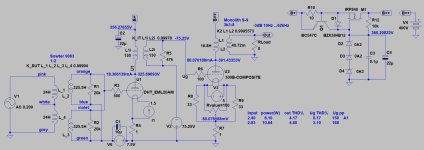

The requiring grid swing (up to A1) about 150Vpp.
The NC20 is 1:1 interstage, so -if you want two stage amplifier- at least 26x gain requiring (if the input is 2VRMS= 2.828Vp for maximum power).
With 2dB gain headroom at least 30dB (33x) gain preferred.
10Y has 8x, EML30a appr. 30x.
EML30a has 6k2 impedance, requiring 19k load.
http://www.emissionlabs.com/datasheets/EML-12B-20A-20B-30A.html
NC20 is 5k 1:1 transformer, with 70H primary inductance.
70H at 20Hz about 8k8 impedance.
IMHO it's not perfect choice for EML30a.
I would rather choose high gm trioded pentode. I prefer D3a, or C3g which are have enough low output impedance for such interstage.
If you insist to use DHT VAS stage, 1:2 SUT, EML20a(m), NC20, 300B is feasible.
Sample (higher op. point):

You can make a really nice 300B with those interstages however I want to warn you that the 45 is in a different league, despite its low power. So much so that I have stayed with it. I use it in Parallel SE or PP for more power and prefer it to the 300B.Hi,
First post here after reading many interesting and enlightening topics. I’ve just finished a simple 45 amplifier, and was so positively surprised I decided to build a second amp. This so the 45 can do what I built it for: drive my headphones in the office.
I just made the mistake of trying it on my speakers and despite their low efficiency the sound is so addictive the amp is not moving to the office until I’ve built a proper “speaker” amp!
So here we are, I’d like to build a 300B amp: I’ve acquired a pair of tango NC20 interstage transformers (original make) and have a set of Audio-note Output transformers (single ended). All I need is a schematic
I do like the idea of keeping everything DHT and simple, because then it’s easier to grasp given my limited knowledge and philosophically I like simple: also this would allow me to study the effect of swapping individual components to tailor the sound. (I’m not looking for something that measures well per se, it should sound well, not for opening that discussion)
I like the 45 sound but that probably has too little amplification to keep it two stages, which would be the preference, also one could avoid coupling capacitors but am open to be convinced otherwise. Should I look at a 10y? EML 30a?
In any case curious to hear peoples thoughts.
Cheers!
Matthew
The EML30 is certainly a good candidate. See my post #489 here and also successive screenshot of impeccable performance from Vega65:
https://www.diyaudio.com/community/threads/300b-se-with-a-dht-driver.352897/page-25#post-7609588
Another solution might be a triode-strapped D3a or something similar.
There is nothing wrong with 3-stages, especially if you end-up with an integrated amplifier. You can easily DC-couple the first stage and the driver as you are not going to waste supply voltage on the driver's plate (thanks to the interstage). This opens to a lot more options.
Last edited:
That is the small signal inductance. I think it's just 1V, if I remember correctly. With larger signal, where more inductance will be required it will be some 30% more.NC20 is 5k 1:1 transformer, with 70H primary inductance.
70H at 20Hz about 8k8 impedance.
IMHO it's not perfect choice for EML30a.
The inductive impedance at 20Hz is not really a good parameter to assess the performance. If the tube is run with sufficient current there is no problem at all. It's not a power stage where you swing the full current.
Requiring 200V peak to peak output to get max performance out of the 300B: with 70H at 20 Hz the EML30 is required to provide 16 mA peak. But in reality it will be some 12mA peak thanks to the increased inductance with large signal. Then, in a typical 8W 300B amp it will be even less, no more than 10mA peak. With a quiescent current of 20 mA that tube will be running quite linearly. Not to mention that at 20Hz there is very little happening and that from 30Hz will have very few rivals.
Last edited:
Thanks all for the responses!
@euro21 thanks for the schematic (impressive in such short time) and suggestion, I see the mesh EML20 has a slightly higher (22) amplification and higher Rp (4k5) or would a lower Ro actually be better?
@45 I go back and forth in my mind between the two, but am thinking it the additional power might give me some added flexibility and I can get the audio note OPT for a good price (which are for single ended 300b).
Now I’m not married to the two stage concept, so if adding a stage provides audible benefits I’m open to that as well. (Oops did I just open a rabbithole…)
Indeed I’d like to make it a integrated amp with volume control (I’m thinking stepped ladder attenuator).
Again thanks!
@euro21 thanks for the schematic (impressive in such short time) and suggestion, I see the mesh EML20 has a slightly higher (22) amplification and higher Rp (4k5) or would a lower Ro actually be better?
@45 I go back and forth in my mind between the two, but am thinking it the additional power might give me some added flexibility and I can get the audio note OPT for a good price (which are for single ended 300b).
Now I’m not married to the two stage concept, so if adding a stage provides audible benefits I’m open to that as well. (Oops did I just open a rabbithole…)
Indeed I’d like to make it a integrated amp with volume control (I’m thinking stepped ladder attenuator).
Again thanks!
You can still ape the circuit with interstage transformer without using a stacked power supply and keep it more conventional. It will end up looking similar to the Shishido 300B amp in the second schematic which indeed uses a Tango NC-20 interstage transformer.Sorry it is a classic circuit, but not using a NC20 as driver (have to wait to post until after coffee). The triode connected 6V6 is choke loaded and the supplies are "stacked" to allow direct coupling of the driver to the 300B.


Last edited:
@euro21 Thanks, D3a seems to be getting quite some praise and the schematic looks simple enough that it warrants trying it as one of the options.
@directdriver, Shishido looks to be quite a legend, do you have any experience listening to a scheme like the one you posted?
Finally, if someone has ideas on full triode (preferably DHT) 3 stage amp, I'd be keen to hear them.
@directdriver, Shishido looks to be quite a legend, do you have any experience listening to a scheme like the one you posted?
Finally, if someone has ideas on full triode (preferably DHT) 3 stage amp, I'd be keen to hear them.
If I remember correctly, Shishido's typical circuits had the following topology:
An Interstage transformer that did Not have an Air Gap.
A driver tube, that put quiescent DC current in the interstage primary.
The output tube was an RF tube that wanted/needed quiescent DC current;
so a positive supply was connected to the bottom of the interstage secondary, and the top of the interstage secondary was connected to the grid of the RF output tube.
Shishido's genius was to make the mA x primary turns = the mA x secondary turns.
Then, the quiescent DC current of the primary, versus the quiescent DC current of the secondary were connected in opposite polarity.
+mA primary turns = -mA secondary turns. That way the magnetization directions cancelled (No need for an air gap)
Once you understand it, you end up thinking why did you or I not think of that way to do things.
The Interstage transformer performance was very good, because the Shishido topology did not require an air gap
Note: there is no schematic in Post # 1 through post # 16 that shows Shishido's non air gapped interstage.
The schematics posted ALL require an Air Gap; they all have quiescent DC current in the primary, but No quiescent DC current in the secondary.
An Interstage transformer that did Not have an Air Gap.
A driver tube, that put quiescent DC current in the interstage primary.
The output tube was an RF tube that wanted/needed quiescent DC current;
so a positive supply was connected to the bottom of the interstage secondary, and the top of the interstage secondary was connected to the grid of the RF output tube.
Shishido's genius was to make the mA x primary turns = the mA x secondary turns.
Then, the quiescent DC current of the primary, versus the quiescent DC current of the secondary were connected in opposite polarity.
+mA primary turns = -mA secondary turns. That way the magnetization directions cancelled (No need for an air gap)
Once you understand it, you end up thinking why did you or I not think of that way to do things.
The Interstage transformer performance was very good, because the Shishido topology did not require an air gap
Note: there is no schematic in Post # 1 through post # 16 that shows Shishido's non air gapped interstage.
The schematics posted ALL require an Air Gap; they all have quiescent DC current in the primary, but No quiescent DC current in the secondary.
Last edited:
@6A3sUMMER the schematics in post #13 is definitely by Shishido. He built all kinds of SE amps. The one you are talking about has only use for tubes that work with positive grid bias and use an interstage with inverted geometry. Such arrangement has no use with the 300B.
The triode-strapped 6F6 is a very nice driver and the Shishido schematics posted by DirectDriver is just good as it is. No messing around, except maybe the input stage. The other one with the 6V6 is also very good but the 6F6 is better, IME.
The 26 DC-coupled to a 46 is nice a combination for an all DHTs power amp. The 26 + EML20B if integrated.
I personally do not like the sound of the 2-stage amp with tubes like C3g and D3a as drivers. Also prefer 4-5K output transformer with 400-420V anode voltage.
The triode-strapped 6F6 is a very nice driver and the Shishido schematics posted by DirectDriver is just good as it is. No messing around, except maybe the input stage. The other one with the 6V6 is also very good but the 6F6 is better, IME.
The 26 DC-coupled to a 46 is nice a combination for an all DHTs power amp. The 26 + EML20B if integrated.
I personally do not like the sound of the 2-stage amp with tubes like C3g and D3a as drivers. Also prefer 4-5K output transformer with 400-420V anode voltage.
Last edited:
D3a (or E280F) and C3g (or rare C3o) as triode are perfect VAS tube for two stage amplifiers.D3a seems to be getting quite some praise and the schematic looks simple enough that it warrants trying it as one of the options.
Both have low distortion even at large swing, and harmonics distribution results "good tone".
Sample:
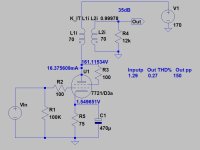
@45 can you elaborate on why the preference for a 4-5k OPT? and between a 26 -> EML20B -> 300b and SUT -> EML20B -> 300b would you have a preference? I know many parameters and component choices, but assume a top notch SUT (I'm mentally starting to prepare for the fact that this build is growing in ambition with the financial concsequences: )
)
- Home
- Amplifiers
- Tubes / Valves
- Ideas input for a Interstage driven 300B SET
